Pronunciation:
(HER-ku-leez)Abbreviation:
HerGenitive:
HerculisRight Ascension:
17 hoursDeclination:
30 degreesArea in Square Degrees:
1225Crosses Meridian:
9 PM, July 25Visible Between Latitudes:
90 and -50 degreesThe constellation Hercules, the strongman, is best seen during the summer in the northern hemisphere. It is visible in the southern hemisphere from May until August at latitudes between 90 degrees and -50 degrees. It is a large constellation filling 1,225 square degrees of the sky. It the fifth largest constellation in the sky, but can be difficult to locate because of its dim stars. It can be found by looking between Draco and Ophiuchus. The constellation is bordered by Draco to the north; Boötes, Corona Borealis, and Serpens Caput to the east; Ophiuchus to the south; Aquila to the southwest; and Sagitta, Vulpecula, and Lyra to the west. Hercules contains a famous grouping of stars known as an asterism. Four stars form a square shape known as the Keystone. The Keystone represents the hero’s torso in the constellation.
Hercules is one of the 48 constellations listed by the Greek astronomer Ptolemy in the second century. It is a very old constellation that was celebrated by a number of ancient cultures. The Sumerians associated the constellation with the hero Gilgamesh. In Greek mythology, it was named after the famous son of Zeus, who defeated the Nemean Lion, Leo, and the many-headed beast called Hydra. While fighting Hydra, Hercules also killed the little crab, Cancer. The Greeks called him Heracles, but the Romans changed his name to Hercules. He is usually depicted as kneeling with his right hand raised above his head holding a club.

points of interest below © Sea and Sky
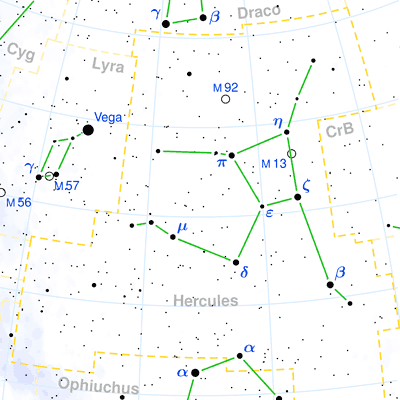
© Torsten Bronger CC BY-SA 3.0
M13
Kornephoros
Zeta Herculis
Sarin
Pi Herculis
Marfak Al Jathih Aisr
Rasalgethi
Sophian
Xi Herculis
Gamma Herculis
Iota Herculis
Atia
Rukbalgethi Genubi
Rukbalgethi Shemali
Epsilon Herculis
Rho Herculis
Sigma Herculis
Phi Herculis
Maasym
Kajam
Chi Herculis
Marfik
N/A
"Club-bearer"
N/A
(Origin Unknown)
N/A
"Left Elbow of the Kneeler"
"Head of the Kneeler"
"Pure"
N/A
N/A
N/A
(Origin Unknown)
"Southern Knee"
"Northern Knee"
N/A
N/A
N/A
N/A
"The Wrist"
"Club"
N/A
"The Elbow"
Globular Star Cluster
Yellow-White Giant Star
Multiple Star System
Multiple Star System
Orange Giant Star
Multiple Star System
Multiple Star System
White Subdwarf Star
Orange Giant Star
Binary Star System
Blue Subgiant Star
Multiple Star System
Orange Giant Star
Blue Subgiant Star
Binary Star System
Double Star System
Blue-White Dwarf Star
Double Star System
Orange Giant Star
Blue Giant Star
Yellow-White Dwarf Star
Binary Star System
5.80
2.77
2.81
3.14
3.15
3.42
3.48
3.49
3.70
3.75
3.75
3.83
3.85
3.89
3.91
4.15
4.20
4.23
4.41
4.58
4.62
5.16
Hercules contains only two stars brighter than magnitude 3. The brightest star is Kornephoros with a visual magnitude of 2.77. It is a yellow-white giant star located approximately 139 light years from Earth. The second brightest star is Zeta Herculis with a magnitude of 2.81. It is a multiple star system only 35 light years away from us. With a magnitude of 3.14, Sarin is the third brightest star in the constellation. It is also a multiple star system composed of as many as five individual stars. It lies approximately 75 light years from our solar system.
Hercules contains two Messier objects and a few notable deep-sky objects. M13, also known as the Hercules Cluster, is a globular star cluster that contains about 300,000 individual stars. M92 is another globular cluster with at least 330,000 stars. Other dim objects in this constellation include a planetary nebula known as Abell 39, a pair of colliding spiral galaxies known as Arp 272, an elliptical galaxy known as NGC 6166, and an active galaxy known as Hercules A. These objects can only be seen with a large telescope.
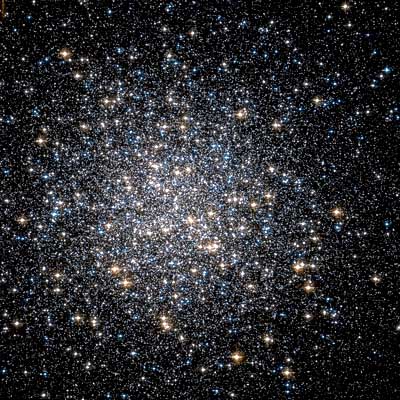
seen by the Hubble Space Telescope
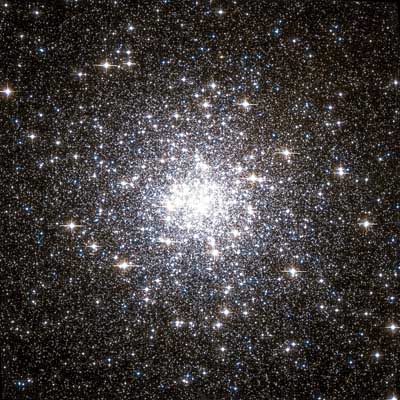
the Hubble Space Telescope
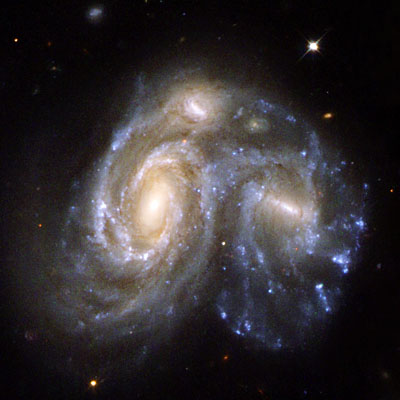
the Hubble Space Telescope
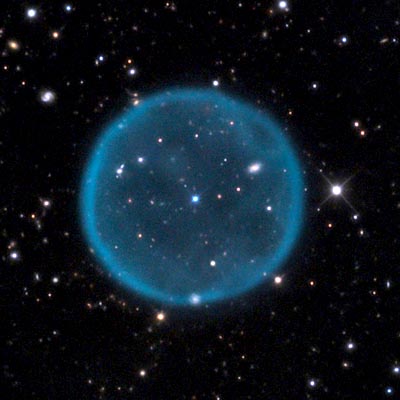
Lemmon SkyCenter/University of Arizona / CC BY 3.0



